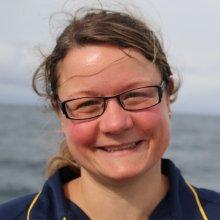
Tamara Baumberger
Tell us about your work/research. What kinds of things do you do?
I am studying the chemical gas composition of cold seeps, hydrothermal vents and submarine volcanoes. Knowing the composition of the sampled gas helps us to understand a lot about its source and the interactions it had during rising and circulation. I collect all my samples from a ship. To do so, I use specially-designed gas-tight sampling bottles attached to a remotely operated vehicle (ROV). Thanks to the ROV video observations from the seafloor and the skills of its pilots, I get my samples exactly from the spot that is most insightful for my science.
What sparked your initial interest in your career?
I was always fascinated by volcanoes and all processes generating new crust. This is the reason why I studied Earth Science.
Who influenced you or encouraged you the most?
I was always (and still am) encouraged by my fascination with the research topic. I also had excellent supervisors during my Ph.D. who gave me many opportunities to participate in research cruises and experience my research first hand. Like this, I was able to follow my samples from when they were collected at sea until the data was published in a journal.
What element of your work/study do you think is the most fascinating?
To observe the Earth formation processes right at sea. My most fascinating experience was to see West Mata volcano erupting right under our feet (well, with a 1200 m body of seawater in between us and the volcano).
What other jobs led you to your current career?
I always pursued a research career in earth sciences.
What are your degrees and certifications?
Diploma in natural sciences (equivalent to a masters degree) from ETH Zurich in Switzerland in 2007 - Doctor of Sciences from ETH Zurich in Switzerland in 2011. My thesis title was Volatiles in Marine Hydrothermal Systems.
What are your hobbies?
I love running, both on the road and on trails. On trails maybe even a little bit better. I am also very much into other outdoorsy activities, such as hiking, backpacking, and kayaking.
What advice would you give someone who wants to have a career like yours?
If you want to do it, go do it!
How did you get involved with the Nautilus Exploration Program? How did you get on the ship?
I was part of the science team during the 2016 expedition. Now I am lucky to be back as the science lead.
Expeditions
Tamara participated in the following Ocean Exploration Trust expeditions:
